HKJ
Flashaholic
[SIZE=+3]My charger do not charge LiIon to 4.2V, is it faulty?[/SIZE]
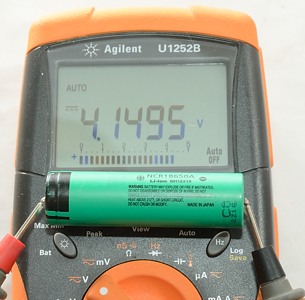
I see this question fairly often and most of the time the answer is: No, it works exactly as it is supposed to do.
Lets start with a typical battery datasheet:
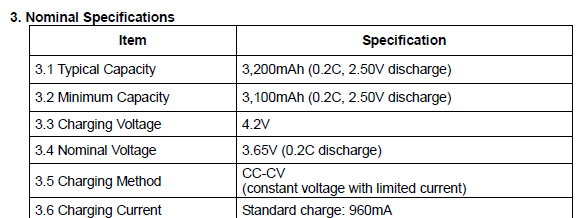
It says the charging voltage must be 4.20 volt, it do not say anything about the battery voltage. It do also say what the standard charge current is (This is the charge current to use if you want the specified number of cycles, higher current will usual reduce the cycle life).

Further down in the datasheet there is a bit more explanation on how to do a standard charge. Cutoff means the current to stop charging at and C is the capacity of the cell, i.e. 0.02C is 0.02x3200 -> 64mA for this 3200mAh cell. I.e. when the charge current has dropped to 64mA, the charger must stop charging (Most chargers uses around 100mA as cutoff current, this means the cell with get slightly less filled and the charge will finish faster).
There is nothing about battery voltage in this, but the charger must supply the 64mA from 4.20 volt.
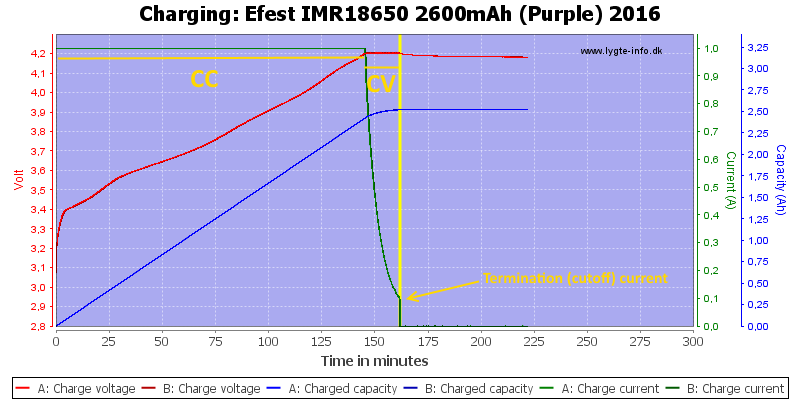
Here is a real charge curve from one of my test stations. I have marked the constant current (CC) and constant voltage (CV). In the CV phase the charger will hold stable 4.20 volt and the current will drop until it is down to the cutoff value. I use the typical 100mA value.
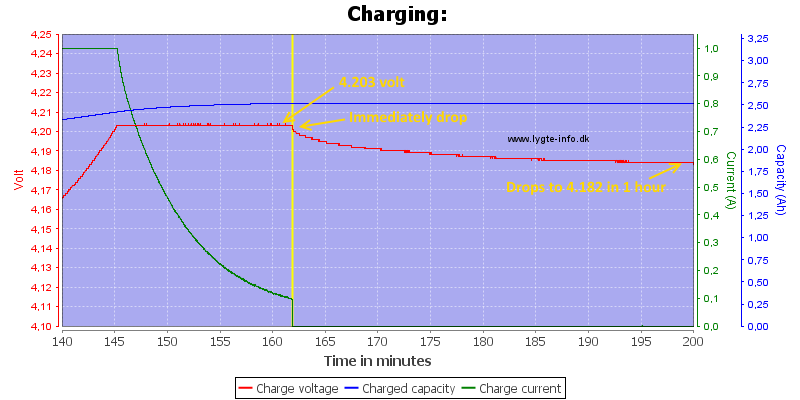
Lets take a closer look on the voltage. The vertical yellow line indicates exactly where the charger stops charging.
As can be seen on the red voltage curve the voltage is 4.203 volt from the charger and the battery voltage is the same while charging in the CV phase. When the charger stops the voltage will drop immediately and continue to drop during the next hour. On this cell I measured 4.182 volt after one hour. Being a new cell in prime condition this is what can be expected, if the cell had been older or the charger had used a higher termination current the drop would have been larger.
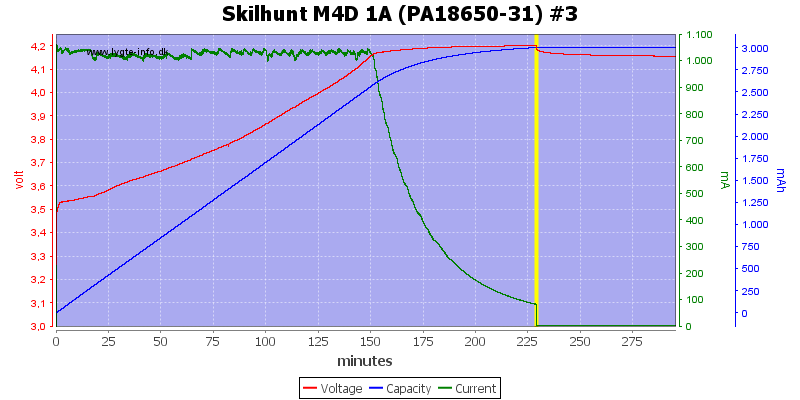
The curve above is sort of ideal, here is a curve from a real charger with a used battery. The CV phase is not as flat (Due to resistance in the charger) and the voltage drop is larger, some of it is because the cell is older.
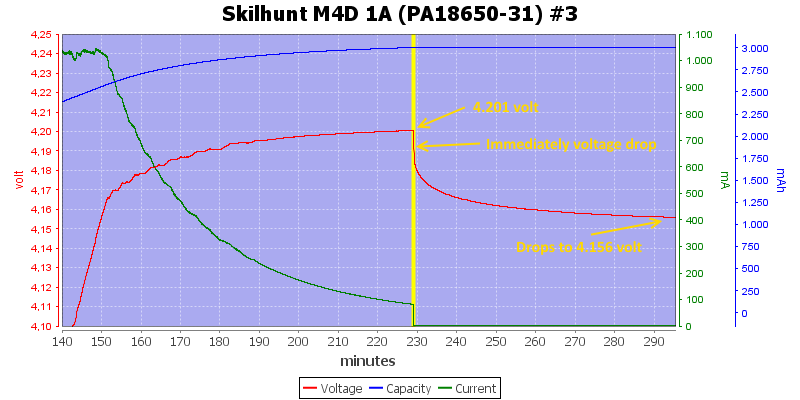
Zooming in and the larger voltage drop is easy to see. This charger is charging with exactly 4.201 volt, but the battery will not measure more than 4.18 volt after the charger stops and after some minutes it will be 4.16 volt.
This is not a bad battery or nearly worn down battery, it is only about 10 months old.
[SIZE=+3]What if my battery is above 4.20 volt?[/SIZE]
If the battery after charging is 4.21 volt, does that mean the charger is defective?
Again the answer will often be no, there is some tolerances.
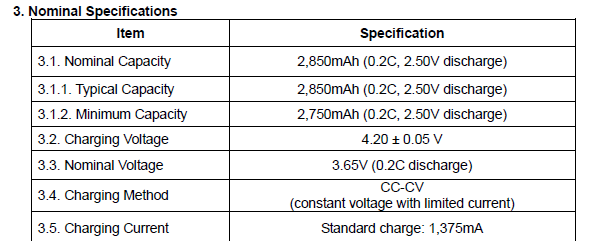
In the first datasheet there was an omission, usual the charge voltage includes a tolerance. The typical tolerance is +/- 0.05 volt, but other values are sometimes used (+/-1% or +/-0.03 volt). This means it is usual possible to add or subtract 0.05 volt to the above values and it is still correct.
If the battery comes out of the charger with 4.25 volt the charge is overcharging the battery, not enough to be dangerous, but the cell will have shorter cycle life.
If the voltage is below 4.10 volt the battery is probably worn down or the charger has a very low charge voltage and/or high termination current.
[SIZE=+3]How do I check the charge voltage?[/SIZE]
This requires a voltmeter and some metal foil strips. It can also requires some patience, depending on the meter.
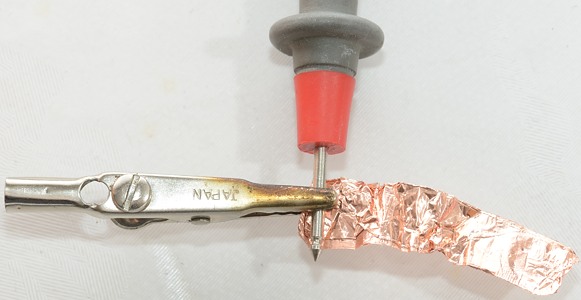
I use copper foil, but aluminium foil from the kitchen can also be used. Be very careful if your use metal alligator clips like I do, the risk of shorts are fairly high and the result can be bad.
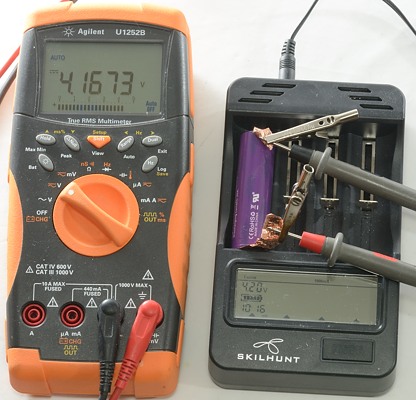
When the charger is nearly finished it is time to turn on the meter and read the voltage. This has to be done at regular intervals, like each 5 minutes. The highest value is the charge voltage.
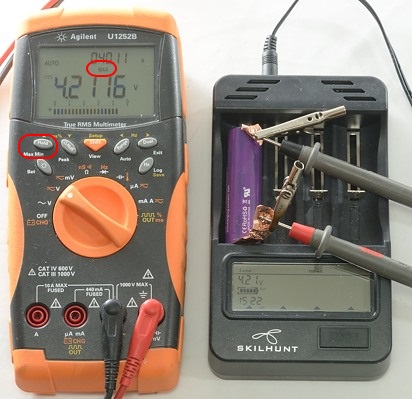
My meter has a max function. Activate that and I can come back when the charger is finished and read the result.
Notes: The charger is not the same as from the curves above. A meter with peak capture cannot be used, it has to be maximum (Peak capture is very fast and will probably capture switching noise from the charger).
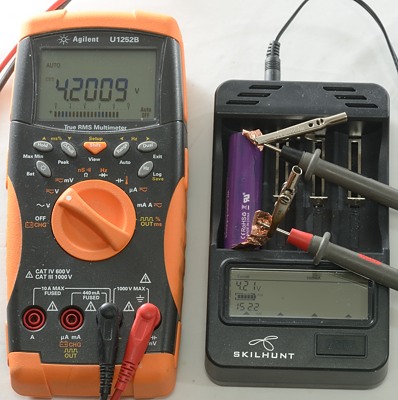
Disabling max again and the voltage is lower, due to the voltage drop when the charge current terminates (Not that much lower, this is a new battery).
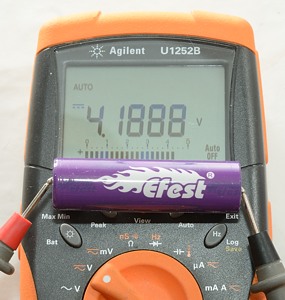
It is also hopeless to measure later.
For the charger to be within specifications the charge voltage must be between 4.15 volt and 4.25 volt. Values below 4.15 volt will increase the lifetime of the battery and charge it to a lower capacity. Values above 4.25 volt will charge to a higher capacity and lower battery lifetime, getting much above 4.25 volt will also increase the danger.
[SIZE=+3]Notes[/SIZE]
Many cheap meter will show wrong voltage when the battery is about empty. If you charger suddenly overcharges or undercharges according to you meter, try replacing the battery in the meter.

I see this question fairly often and most of the time the answer is: No, it works exactly as it is supposed to do.
Lets start with a typical battery datasheet:

It says the charging voltage must be 4.20 volt, it do not say anything about the battery voltage. It do also say what the standard charge current is (This is the charge current to use if you want the specified number of cycles, higher current will usual reduce the cycle life).

Further down in the datasheet there is a bit more explanation on how to do a standard charge. Cutoff means the current to stop charging at and C is the capacity of the cell, i.e. 0.02C is 0.02x3200 -> 64mA for this 3200mAh cell. I.e. when the charge current has dropped to 64mA, the charger must stop charging (Most chargers uses around 100mA as cutoff current, this means the cell with get slightly less filled and the charge will finish faster).
There is nothing about battery voltage in this, but the charger must supply the 64mA from 4.20 volt.

Here is a real charge curve from one of my test stations. I have marked the constant current (CC) and constant voltage (CV). In the CV phase the charger will hold stable 4.20 volt and the current will drop until it is down to the cutoff value. I use the typical 100mA value.

Lets take a closer look on the voltage. The vertical yellow line indicates exactly where the charger stops charging.
As can be seen on the red voltage curve the voltage is 4.203 volt from the charger and the battery voltage is the same while charging in the CV phase. When the charger stops the voltage will drop immediately and continue to drop during the next hour. On this cell I measured 4.182 volt after one hour. Being a new cell in prime condition this is what can be expected, if the cell had been older or the charger had used a higher termination current the drop would have been larger.

The curve above is sort of ideal, here is a curve from a real charger with a used battery. The CV phase is not as flat (Due to resistance in the charger) and the voltage drop is larger, some of it is because the cell is older.

Zooming in and the larger voltage drop is easy to see. This charger is charging with exactly 4.201 volt, but the battery will not measure more than 4.18 volt after the charger stops and after some minutes it will be 4.16 volt.
This is not a bad battery or nearly worn down battery, it is only about 10 months old.
[SIZE=+3]What if my battery is above 4.20 volt?[/SIZE]
If the battery after charging is 4.21 volt, does that mean the charger is defective?
Again the answer will often be no, there is some tolerances.

In the first datasheet there was an omission, usual the charge voltage includes a tolerance. The typical tolerance is +/- 0.05 volt, but other values are sometimes used (+/-1% or +/-0.03 volt). This means it is usual possible to add or subtract 0.05 volt to the above values and it is still correct.
If the battery comes out of the charger with 4.25 volt the charge is overcharging the battery, not enough to be dangerous, but the cell will have shorter cycle life.
If the voltage is below 4.10 volt the battery is probably worn down or the charger has a very low charge voltage and/or high termination current.
[SIZE=+3]How do I check the charge voltage?[/SIZE]
This requires a voltmeter and some metal foil strips. It can also requires some patience, depending on the meter.

I use copper foil, but aluminium foil from the kitchen can also be used. Be very careful if your use metal alligator clips like I do, the risk of shorts are fairly high and the result can be bad.

When the charger is nearly finished it is time to turn on the meter and read the voltage. This has to be done at regular intervals, like each 5 minutes. The highest value is the charge voltage.

My meter has a max function. Activate that and I can come back when the charger is finished and read the result.
Notes: The charger is not the same as from the curves above. A meter with peak capture cannot be used, it has to be maximum (Peak capture is very fast and will probably capture switching noise from the charger).

Disabling max again and the voltage is lower, due to the voltage drop when the charge current terminates (Not that much lower, this is a new battery).

It is also hopeless to measure later.
For the charger to be within specifications the charge voltage must be between 4.15 volt and 4.25 volt. Values below 4.15 volt will increase the lifetime of the battery and charge it to a lower capacity. Values above 4.25 volt will charge to a higher capacity and lower battery lifetime, getting much above 4.25 volt will also increase the danger.
[SIZE=+3]Notes[/SIZE]
Many cheap meter will show wrong voltage when the battery is about empty. If you charger suddenly overcharges or undercharges according to you meter, try replacing the battery in the meter.
Last edited:

